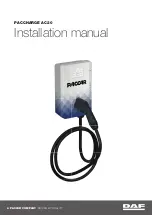
Near
Changing the FCW sensitivity to the “Near”
setting, allows the system to warn you of a
potential frontal collision when you are much
closer.
This setting provides less reaction time than the
“Far” setting, which allows for a more dynamic
driving experience.
More dynamic or aggressive drivers that want to
avoid frequent warnings may prefer this setting.
Refer to your Owner's Manual for further details.
WARNING!
Forward Collision Warning (FCW) is not in-
tended to avoid a collision on its own, nor can
FCW detect every type of potential collision.
The driver has the responsibility to avoid a
collision by controlling the vehicle via brak-
ing and steering. Failure to follow this warn-
ing could lead to serious injury or death.
General Information
The following regulatory statement applies to all
Radio Frequency (RF) devices equipped in this
vehicle:
This device complies with Part 15 of the FCC
Rules and with Industry Canada license-exempt
RSS standard(s). Operation is subject to the
following two conditions:
1. This
device
may
not
cause
harmful
interference.
2. This device must accept any interference
received, including interference that may
cause undesired operation.
NOTE:
Changes or modifications not expressly ap-
proved by the party responsible for compliance
could void the user’s authority to operate the
equipment.
Tire Pressure Monitor System (TPMS)
NOTE:
For vehicles equipped with run flat tires —
when the TPMS indicates a tire pressure of
14 psi (96 kPa) or lower, always check tire
pressure and replace the tire at the first oppor-
tunity. At inflation pressure of/or below 14 psi
(96 kPa) the tire is in the run-flat mode of
operation. In this condition, it is recommended
a vehicle maximum speed of 50 mph (80 km/h)
for a maximum distance of 50 miles (80 km).
The manufacturer does not recommend using
the run flat feature while driving a vehicle
loaded at full capacity or towing a trailer.
The Tire Pressure Monitoring System (TPMS)
will warn the driver of a low tire pressure based
on the vehicle recommended cold tire pressure.
The tire pressure will vary with temperature by
about 1 psi (7 kPa) for every 12°F (6.5°C). This
means that when the outside temperature de-
creases, the tire pressure will decrease. Tire
pressure should always be set based on cold
inflation tire pressure. This is defined as the tire
pressure after the vehicle has not been driven
for at least three hours, or driven less than
1 mile (1.6 km) after a three-hour period.
Refer
SAFETY
84
Содержание DURANGO 2019
Страница 6: ...4 ...
Страница 215: ...213 ...
Страница 248: ...Using The Touchscreen Radio Rear Media Control Screen MULTIMEDIA 246 ...
Страница 278: ...276 ...
Страница 279: ...277 ...
Страница 280: ...278 ...
Страница 281: ...279 ...
Страница 282: ...280 ...
















































